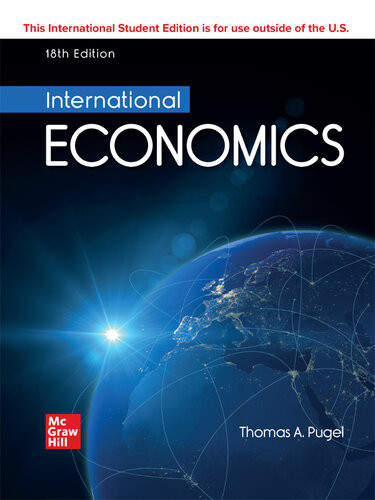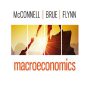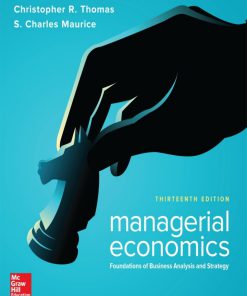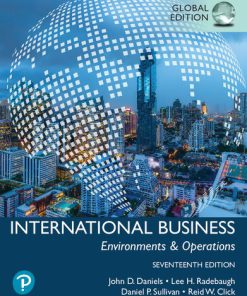International Economics 18th Edition by Thomas Pugel 9781266833410 1266833412
$50.00 Original price was: $50.00.$25.00Current price is: $25.00.
International Economics 18th Edition Thomas Pugel – Ebook Instant Download/Delivery ISBN(s): 9781266131752,1266131752 ,9781266833410, 1266833412
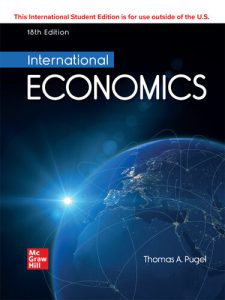
Product details:
- ISBN 10: 1266833412
- ISBN 13: 9781266833410
- Author: Thomas Pugel
International Economics
Table contents:
Chapter 1: International Economics Is Different
Chapter One Introduction
Four Controversies
The Global COVID-19 Pandemic Crisis
Immigration
Brexit
Switzerland’s Exchange Rate
Economics and the Nation-State
Factor Mobility
Different Fiscal Policies
Different Moneys
Chapter 2: The Basic Theory Using Demand and Supply
Chapter Two Introduction
Four Questions About Trade
Demand and Supply
Demand
Consumer Surplus
Supply
Producer Surplus
A National Market with No Trade
Two National Markets and the Opening of Trade
Free-Trade Equilibrium
Effects in the Importing Country
Effects in the Exporting Country
Which Country Gains More?
Summary: Early Answers to the Four Trade Questions
Key Terms
Suggested Reading
Questions and Problems
Chapter 3: Why Everybody Trades: Comparative Advantage
Chapter Three Introduction
Adam Smith’s Theory of Absolute Advantage
Ricardo’s Theory of Comparative Advantage
Ricardo’s Constant Costs and the Production-Possibility Curve
Summary
Key Terms
Suggested Reading
Questions and Problems
Chapter 4: Trade: Factor Availability and Factor Proportions Are Key
Chapter Four Introduction
Production with Increasing Marginal Costs
What’s behind the Bowed-Out Production-Possibility Curve?
What Production Combination Is Actually Chosen?
Community Indifference Curves
Production and Consumption Together
Without Trade
With Trade
Demand and Supply Curves Again
The Gains From Trade
Trade Affects Production and Consumption
What Determines the Trade Pattern?
The Heckscher–Ohlin (H–O) Theory
Summary
Key Terms
Suggested Reading
Questions and Problems
Chapter 5: Who Gains and Who Loses from Trade?
Chapter Five Introduction
Who Gains and Who Loses Within a Country
Short-Run Effects of Opening Trade
The Long-Run Factor-Price Response
Three Implications of the H–O Theory
The Stolper–Samuelson Theorem
The Specialized-Factor Pattern
The Factor-Price Equalization Theorem
Does Heckscher–Ohlin Explain Actual Trade Patterns?
Factor Endowments
International Trade
Do Factor Prices Equalize Internationally?
Summary: Fuller Answers to the Four Trade Questions
Key Terms
Suggested Reading
Questions and Problems
Chapter 6: Scale Economies, Imperfect Competition, and Trade
Chapter Six Introduction
Scale Economies
Internal Scale Economies
External Scale Economies
Intra-Industry Trade
How Important Is Intra-Industry Trade?
What Explains Intra-Industry Trade?
Monopolistic Competition and Trade
The Market with No Trade
Opening to Free Trade
Basis for Trade
Gains from Trade
Oligopoly and Trade
Substantial Scale Economies
Oligopoly Pricing
External Scale Economies and Trade
Summary: How Does Trade Really Work?
Key Terms
Suggested Reading
Questions and Problems
Chapter 7: Growth and Trade
Chapter Seven Introduction
Balanced Versus Biased Growth
Growth in Only One Factor
Changes in the Country’s Willingness to Trade
Effects on the Country’s Terms of Trade
Small Country
Large Country
Immiserizing Growth
Technology and Trade
Individual Products and the Product Cycle
Openness to Trade Affects Growth
Summary
Key Terms
Suggested Reading
Questions and Problems
Chapter 8: Analysis of a Tariff
Chapter Eight Introduction
A Preview of Conclusions
The Effect of a Tariff on Domestic Producers
The Effect of a Tariff on Domestic Consumers
The Tariff as Government Revenue
The Net National Loss from a Tariff
The Terms-of-Trade Effect and a Nationally Optimal Tariff
Summary
Key Terms
Suggested Reading
Questions and Problems
Chapter 9: Nontariff Barriers to Imports
Chapter Nine Introduction
Types of Nontariff Barriers to Imports
The Import Quota
Quota Versus Tariff for a Small Country
Ways to Allocate Import Licenses
Quota Versus Tariff for a Large Country
Voluntary Export Restraints
Other Nontariff Barriers
Product Standards
Domestic Content Requirements
Government Procurement
How Big are the Costs of Protection?
As a Percentage of GDP
As the Extra Cost of Helping Domestic Producers
International Trade Disputes
America’s “Section 301”: Unilateral Pressure
Dispute Settlement in the WTO
Summary
Key Terms
Suggested Reading
Questions and Problems
Chapter 10: Arguments for and against Protection
Chapter Ten Introduction
The Ideal World of First Best
The Realistic World of Second Best
Government Policies Toward Externalities
The Specificity Rule
Promoting Domestic Production or Employment
The Infant Industry Argument
How It Is Supposed to Work
How Valid Is It?
The Dying Industry Argument and Adjustment Assistance
Should the Government Intervene?
Trade Adjustment Assistance
The Developing Government (Public Revenue) Argument
Other Arguments For Protection: Noneconomic Objectives
National Pride
National Defense
Income Redistribution
The Politics of Protection
The Basic Elements of the Political–Economic Analysis
When Are Tariffs Unlikely?
When Are Tariffs Likely?
Applications to Other Trade-Policy Patterns
Summary
Key Terms
Suggested Reading
Questions and Problems
Chapter 11: Pushing Exports
Chapter Eleven Introduction
Dumping
Reacting to Dumping: What Should a Dumpee Think?
Actual Antidumping Policies: What is Unfair?
Proposals For Reform
Export Subsidies
Exportable Product, Small Exporting Country
Exportable Product, Large Exporting Country
Switching an Importable Product Into an Exportable Product
WTO Rules on Subsidies
Should the Importing Country Impose Countervailing Duties?
Strategic Export Subsidies Could Be Good
Summary
Key Terms
Suggested Reading
Questions and Problems
Chapter 12: Trade Blocs and Trade Blocks
Chapter Twelve Introduction
Types of Economic Blocs
Is Trade Discrimination Good or Bad?
The Basic Theory of Trade Blocs: Trade Creation and Trade Diversion
Other Possible Gains from a Trade Bloc
The EU Experience
North America As a Bloc
NAFTA: Provisions and Controversies
NAFTA: Effects
Rules of Origin
NAFTA Becomes the USMCA
Trade Blocs Among Developing Countries
Trade Embargoes
Summary
Key Terms
Suggested Reading
Questions and Problems
Chapter 13: Trade and the Environment
Chapter Thirteen Introduction
Is Free Trade Anti-Environment?
Is The Wto Anti-Environment?
The Specificity Rule Again
A Preview of Policy Prescriptions
Trade and Domestic Pollution
Transborder Pollution
The Right Solution
A Next-Best Solution
NAFTA, the USMCA, and the Environment
Global Environmental Challenges
Global Problems Need Global Solutions
Extinction of Species
Overfishing
CFCs and Ozone
Greenhouse Gases and Global Warming
Summary
Key Terms
Suggested Reading
Questions and Problems
Chapter 14: Trade Policies for Developing Countries
Chapter Fourteen Introduction
Which Trade Policy for Developing Countries?
Are The Long-Run Price Trends Against Primary Producers?
International Cartels to Raise Primary-Product Prices
The OPEC Victories
Classic Monopoly as an Extreme Model for Cartels
The Limits to and Erosion of Cartel Power
Oil Prices since 1999
Other Primary Products
Import-Substituting Industrialization
ISI at Its Best
Experience with ISI
Exports of Manufactures to Developed Countries
Summary
Key Terms
Suggested Reading
Questions and Problems
Chapter 15: Multinationals and Migration: International Factor Movements
Chapter Fifteen Introduction
Foreign Direct Investment
Multinational Enterprises
FDI: History and Current Patterns
Why Do Multinational Enterprises Exist?
Inherent Disadvantages
Firm-Specific Advantages
Location Factors
Internalization Advantages
Oligopolistic Rivalry
Taxation of Multinational Enterprises’ Profits
MNEs and International Trade
Should the Home Country Restrict FDI Outflows?
Should the Host Country Restrict FDI Inflows?
Migration
How Migration Affects Labor Markets
Should the Sending Country Restrict Emigration?
Should the Receiving Country Restrict Immigration?
Effects on the Government Budget
External Costs and Benefits
What Policies to Select Immigrants?
Summary
Key Terms
Suggested Reading
Questions and Problems
Chapter 16: Payments among Nations
Chapter Sixteen Introduction
Accounting Principles
A Country’s Balance of Payments
Current Account
Financial Account
Official International Reserves
Statistical Discrepancy
The Macro Meaning of the Current Account Balance
The Macro Meaning of the Overall Balance
The International Investment Position
Summary
Key Terms
Suggested Reading
Questions and Problems
Chapter 17: The Foreign Exchange Market
Chapter Seventeen Introduction
The Basics of Currency Trading
Using the Foreign Exchange Market
Interbank Foreign Exchange Trading
Demand and Supply for Foreign Exchange
Floating Exchange Rates
Fixed Exchange Rates
Current Arrangements
Arbitrage within the Spot Exchange Market
Summary
Key Terms
Suggested Reading
Questions and Problems
Chapter 18: Forward Exchange and International Financial Investment
Chapter Eighteen Introduction
Exchange-Rate Risk
The Market Basics of Forward Foreign Exchange
Hedging Using Forward Foreign Exchange
Speculating Using Forward Foreign Exchange
International Financial Investment
International Investment with Cover
Covered Interest Arbitrage
Covered Interest Parity
International Investment Without Cover
Does Interest Parity Really Hold? Empirical Evidence
Evidence on Covered Interest Parity
Evidence on Uncovered Interest Parity
Evidence on Forward Exchange Rates and Expected Future Spot Exchange Rates
Summary
Key Terms
Suggested Reading
Questions and Problems
Chapter 19: What Determines Exchange Rates?
Chapter Nineteen Introduction
A Road Map
Exchange Rates in the Short Run
The Role of Interest Rates
The Role of the Expected Future Spot Exchange Rate
The Long Run: Purchasing Power Parity (PPP)
The Law of One Price
Absolute Purchasing Power Parity
Relative Purchasing Power Parity
Relative PPP: Evidence
The Long Run: The Monetary Approach
Money, Price Levels, and Inflation
Money and PPP Combined
The Effect of Money Supplies on an Exchange Rate
The Effect of Real Incomes on an Exchange Rate
Exchange-Rate Overshooting
How Well Can We Predict Exchange Rates?
Four Ways to Measure the Exchange Rate
Summary
Key Terms
Suggested Reading
Questions and Problems
Chapter 20: Government Policies toward the Foreign Exchange Market
Chapter Twenty Introduction
Two Aspects: Rate Flexibility and Restrictions on Use
Floating Exchange Rate
Fixed Exchange Rate
What to Fix To?
When to Change the Fixed Rate?
Defending a Fixed Exchange Rate
Defense Through Official Intervention
Defending against Depreciation
Defending against Appreciation
Temporary Disequilibrium
Disequilibrium That Is Not Temporary
Exchange Control
International Currency Experience
The Gold Standard Era, 1870–1914 (One Version of Fixed Rates)
Interwar Instability
The Bretton Woods Era, 1944–1971 (Adjustable Pegged Rates)
The Current System: Limited Anarchy
Summary
Key Terms
Suggested Reading
Questions and Problems
Chapter 21: International Lending and Financial Crises
Chapter Twenty-One Introduction
Gains and Losses from Well-Behaved International Lending
Taxes on International Lending
International Lending to Developing Countries
The Surge in International Lending, 1974–1982
The Debt Crisis of 1982
The Resurgence of Capital Flows in the 1990s
The Mexican Crisis, 1994–1995
The Asian Crisis, 1997
The Russian Crisis, 1998
Argentina’s Crisis, 2001–2002
Capital Flows since 2002
Financial Crises: What Can and Does Go Wrong
Overlending and Overborrowing
Exogenous International Shocks
Exchange-Rate Risk
Fickle International Short-Term Lending
Global Contagion
Resolving Financial Crises
Rescue Packages
Debt Restructuring
Reducing the Frequency of Financial Crises
Bank Regulation and Supervision
Capital Controls
Global Financial and Economic Crisis
How the Crisis Happened
Causes and Amplifiers
Summary
Key Terms
Suggested Reading
Questions and Problems
Chapter 22: How Does the Open Macroeconomy Work?
Chapter Twenty-Two Introduction
The Performance of a National Economy
A Framework for Macroeconomic Analysis
Domestic Production Depends on Aggregate Demand
Trade Depends on Income
Equilibrium GDP and Spending Multipliers
Equilibrium GDP
The Spending Multiplier in a Small Open Economy
Foreign Spillovers and Foreign-Income Repercussions
A More Complete Framework: Three Markets
The Domestic Product Market
The Money Market
The Foreign Exchange Market (or Balance of Payments)
Three Markets Together
The Price Level Does Change
Trade Also Depends on Price Competitiveness
Summary
Key Terms
Suggested Reading
Questions and Problems
Chapter 23: Internal and External Balance with Fixed Exchange Rates
Chapter Twenty-Three Introduction
From the Balance of Payments to the Money Supply
The Central Bank’s Balance Sheet and the Money Supply
Official Foreign Exchange Intervention
From the Money Supply Back to the Balance of Payments
Sterilization
Monetary Policy With Fixed Exchange Rates
Fiscal Policy With Fixed Exchange Rates
Perfect Capital Mobility
Shocks to the Economy
Internal Shocks
International Capital-Flow Shocks
International Trade Shocks
Imbalances and Policy Responses
Internal and External Imbalances
A Short-Run Solution: Monetary–Fiscal Mix
Surrender: Changing the Exchange Rate
How Well Does the Trade Balance Respond to Changes in the Exchange Rate?
How the Response Could Be Unstable
Why the Response Is Probably Stable
Timing: The J Curve
Summary
Key Terms
Suggested Reading
Questions and Problems
Chapter 24: Floating Exchange Rates and Internal Balance
Chapter Twenty-Four Introduction
Monetary Policy With Floating Exchange Rates
Fiscal Policy With Floating Exchange Rates
Shocks to the Economy
Internal Shocks
International Capital-Flow Shocks
International Trade Shocks
Internal Imbalance and Policy Responses
International Macroeconomic Policy Coordination
People also search:
international economics 18th edition thomas pugel
thomas pugel international economics 18th edition
thomas pugel international economics 18th edition mcgraw-hill
thomas pugel international economics 17th edition
international economics thomas pugel
You may also like…
Business & Economics - Econometrics
International Economics, 8th Edition, Global Edition James Gerber
Business & Economics - Others
Business & Economics - Economics
Uncategorized
Children's Books
Economics for Cambridge International AS and A Level Terry Cook
Reference - School Guides & Test Preparation
Business & Economics - Econometrics
Business & Economics
Business & Economics - Sales & Marketing
ISE International Marketing, 18e 18th Edition Philip R. Cateora

